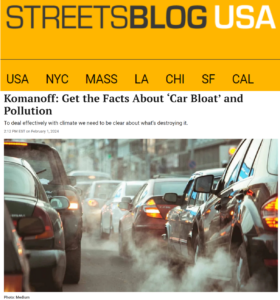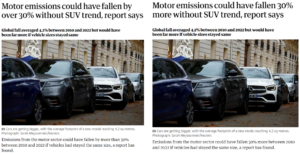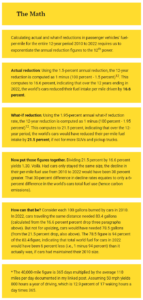Streetsblog USA today published my essay, Get the Facts About ‘Car Bloat’ and Pollution. I’ve cross-posted it here to allow comments.
— C.K., Feb. 1, 2024

The increasing size of passenger vehicles has been catastrophic for road safety, traffic congestion, climate viability, and household budgets. Compared to sedans, brawnier sport utility vehicles and pickup trucks are far more likely to kill other road users, to clog urban streets and suburban roads, to guzzle fuel and emit particulates and carbon, and to keep their owners on a treadmill of car payments and pain at the pump.
Not only that, SUVs and pickups — collectively designated “light trucks” by regulators (“deregulators” is more apt) — may even engender more driving by owners seduced by their roominess, faux road-worthiness and illusion of indomitability. All 12 of the dozen models most preferred by gasoline “superusers” — drivers in the top decile of U.S. gasoline consumption — are SUVs or pickups, with the Chevy Silverado and Ford F150 topping the list.
As I wrote earlier this week, superusers manage the bizarre feat of averaging 40,000 miles a year* — a quantity of driving that consumes 13 percent of their owners’ waking hours — while burning 22 percent more fuel per mile than other U.S. drivers’ rides. Ivan Illich was right.
Just after Thanksgiving, The Guardian added its two cents with a story headlined, “Motor emissions could have fallen over 30 percent without SUV trends, report says.” Translated: Global CO2 emissions from passenger vehicles would have shrunk by nearly one-third if not for vehicle upsizing to SUVs and pickups.
Startling and damning, right? But it’s a vast overstatement: The true 2010-2022 “lost reduction” in passenger vehicles’ carbon emissions due to the growing share of big trucks worldwide was just 6 percent — five times less than the reported 30 percent.
Wait, am I cutting SUVs a break on their carbon spewing? Not at all. To deal effectively with climate we need to be clear about what’s destroying it.
The false 30-percent figure — which you’ll soon see wasn’t the fault of the Guardian — has begun worming its way into energy and climate discourse. This is unfortunate, since it serves to reinforce emphasis on the types of vehicles being made, sold and driven, when American motorists’ carbon profligacy is the inevitable result of our oversupply of pavement and our bias against full-cost pricing of driving.
Whence the error?
The Global Fuel Economy Initiative is a think tank funded by the European Commission, the Global Environment Facility, the UN Environment Programme and the FIA Foundation. Notwithstanding the fact that FIA is the “philanthropic arm” of the Fédération Internationale de l’Automobile (aka Formula One auto racing), GFEI produces high-caliber analysis and research.
GFEI’s November 2023 report, “Trends in the Global Vehicle Fleet 2023: Managing the SUV Shift and the EV Transition,” meticulously examined passenger-vehicle fuel consumption over the 12-year period, 2010 to 2022, and found that average fuel use (and, hence, per-mile carbon emissions) dropped by an average rate of 1.5 percent per year.
If not for more and heavier SUVs, the average annual decrease in emissions, according to the report, would have been around 1.95 percent, a rate that is 30 percent greater than the actual decline rate.
A 1.5-percent annual decrease in fuel intake per mile calculates to a total 16.6-percent total drop during the period. (See math box at the bottom of this post for the arithmetic.) Had the annual decrease been 1.95 percent, its 12-year drop would have been 21.5 percent. The gap between those two drops means that bigger car size worsened fuel economy 6 percent more than if car size had remained the same.

The Guardian, before (left) and after I got out my calculator. There’s a difference, but it’s not sharp enough.
Accordingly, the headline in the story should have been, “Motor Emissions Could Have Fallen 6 Percent More Without SUVs, Report Says,” but that’s not exactly eyeball-grabbing. Don’t blame Guardian reporter Helena Horton, however. She wrote her story off of GFEI’s press release, which (incorrectly) trumpeted a lost 30-percent gain in fuel economy due to “the SUV trend.”
After being contacted by me, GFEI’s study director immediately acknowledged his comms team’s error and labored mightily to get The Guardian to run a full correction. As you can tell from the side-by-side story headlines above, he was only partly successful.
The image on the left shows the original Nov. 24 Guardian headline and lede, retrieved via the Web’s Wayback Machine. The image on the right shows the corrected headline and lede since Dec. 18. The alterations are subtle nearly to the point of invisibility. The new “30 percent more” is confusing (30 percent more than what?), and the subhead is unaltered and thus plain wrong to say that the fall in emissions “would have been far more” than it was, had vehicle sizes stayed the same. No, the fall in emissions would have been 6 percent more — not exactly “far more.”
Why it’s important to correct the error

The Guardian’s erroneous “30-percent-less” headline, though not its fault, has the makings of a honey trap. New York Times climate columnist David Wallace-Wells fell for it on Twitter, along with esteemed climate pundit David Roberts. The Colorado-based climate think tank RMI got ensnared as well, as did our own Kea Wilson at Streetsblog USA. (RMI and Streetsblog quickly corrected their flubs after I emailed.) Consider this post an antidote to future repetitions, or, at least, a means to correct them.
It’s also worth touching on the innumeracy required to imagine that auto upsizing — “car bloat” in the evocative phrase popularized by journalist David Zipper — as loathsome as it is, stood in the way of a 30-percent gain in world-average auto fuel economy. The typical difference between sedan and “light truck” mpg is only around 20 percent (though greater in the U.S., with our supersized SUVs and pickups), so even a complete global switchover from sedans to light trucks would have put only a 20-percent dent in fuel economy.
Of course, the actual carbon damage due to vehicle SUV-ification over the 12 years studied has been far less — just 6 percent as we saw above — on account of longer vehicle turnover times. This should have been readily apparent to The Guardian reporter as well as the journalists and advocates who repeated the error on social media or websites. Errant quantification is hardly journalism’s number one albatross — free-falling revenues and shrinking newsrooms are orders of magnitude more consequential — but it lurks under the surface.
With greater numeracy, it might be easier for journalists, advocates and policymakers to grasp that vehicle electrification and shrinkage alone aren’t going to cut auto emissions at the rate needed.
Driving too must shrink. Collectively, road pricing, congestion pricing, curb pricing, carbon pricing, better transit and livable streets are almost certainly at least as important for climate as improved miles per gallon.

James Handley says
Thanks for yet another trenchant myth-breaking analysis.
As it happens, I just read Elizabeth Kolbert’s “The Perverse Policies That Fuel Wildfires,” in the (Feb 5) New Yorker, https://www.newyorker.com/magazine/2024/02/05/the-perverse-policies-that-fuel-wildfires.
This post, your previous one on super-drivers and Kolbert’s essay all spotlight how vehicle choice affects not only fuel consumed per mile, but also driving habits. SUV ownership and super-driving are part of a lifestyle that in the pre-Petrocene era was available only to Pharaohs and kings. Access to cheap oil hasn’t just increased the size, weight and number of our chariots, it has encouraged their owners to drive more and choose bigger, more energy-consuming homes built farther from urban centers into forested areas. When those areas burn (driven in part by fossil fuel driven global warming), the damage and dangers multiply.
It’s a huge vicious cycle with many feedback loops, including political resistance to policy that affects that lifestyle, especially attempts to curb fossil fuel production and burning. As you’ve pointed out for years, a carbon tax would help dampen those behavioral amplifiers of the climate crisis.
Drew Keeling says
Many thanks for this incisive exposé, powerfully highlighting both a key drawback of “substantially unnecessary vehicles,” and more notably how to fact-correct math errors in the press. News media are well-known for numerical illiteracy, especially regarding energy computations, and if there is an “app” against that affliction it is woefully underemployed. Posts like this could in principle appear daily for a year and yet hardly dent the issue. A whole book could be devoted to the topic, as in fact much of McKay’s “Without The Hot Air” is. (He alas died 8 years ago, but the website still exists and is still useful: http://www.withouthotair.com/
Guardian’s goof involves misstating a percentage of a percentage number in a way that makes it seem like a percentage points number. A more common fault is the deliberate obscuring of relevant percentages, to make them more “tangible.” For example: declaring that the energy saved by some new headline-grabbing measure or gadget is enough to “power all homes in Kansas” or to “light all households in Nashville.” Thereby leaving the calculation as an (unnecessarily burdensome) “exercise for the reader,” instead of just directly providing the only percentage that really matters for slowing down global climate change, e.g. the impact on total global carbon emissions. Analogous to the per 100 gram dietary labels on food.
Furthermore, insisting that (contrary to current general practice) press pieces on energy topics always report global carbon emissions percentages, would yield an additional benefit, coming from their relative tininess.
Suppose, as a pure thought experiment, that instead of the 0.45% difference per annum here (compounded over 12 years to 6%, but misreported as 30%), there really was a 30% fall in “motor emissions”. For example, due to a theoretical presidential administration of Cornell West banning use of SUVs globally. Since SUVs happen to account for about 30% of “total car emissions” worldwide (per IEA), universally removing them would indeed reduce total car emissions by 30%. (This also assumes all SUV drivers thereafter retired to places where they would shop and visit by foot, bicycle or ride-hitching, not just switch to regular cars. Or that all cars, not just SUVs, are driven something like 25-30% less, on average. In any case, with “private cars and vans” being 10% of global fossil fuel emissions (IEA again), that would yield a cut in total emissions of 3%. Which, if replicated in some different other sector, year after year, could just about get the world to net zero by 2050. All we’d need is a global dictator decreeing away 3-4% of the current emission level every year for the next quarter century. Or a major permanent market correction of the mother of modern major market failures.
Suppose, less unrealistically, and in part by always clearly referencing relevant and correct % global emission metrics, it could be widely made known that the vast majority of “new trend in energy use” headlines boil down to relative drops in the global carbon footprint bucket, if looked at individually. Such general enlightenment might then help drive home that (short of totalitarian scale fuel rationing) the only single measure realistically scalable globally to meet a half-way acceptable zero carbon target date, is a global externality-correcting global carbon fee pact. Something like a Nordhaus/Hansen border fee “climate club.”
We could and should have known we needed a functional equivalent of that 35 years ago, and it is arguably the greatest failing of current generations, if not all generations, that we have not acted more substantively already. We need major corrective carbon pricing even more now. It is high time for the news media to become a steady part of the solution instead of remaining rutted in serial inadequacy-cloaking.